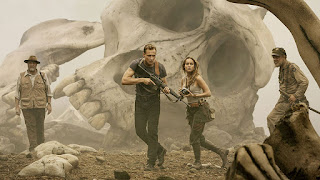In movies as in life, much of one’s happiness depends on expectations. For example, back in 2005, Peter Jackson released his remake of the 1933 classic, King Kong. Because it was Peter Jackson, the genius who had just successfully helmed one of the most ambitious movie projects in history – The Lord of the Rings trilogy – and because the remake was of one of his most beloved films, one that made him want to make movies in the first place, and because it starred Oscar winner Adrian Brody and because the special effects were by Jackson’s own Oscar winning team at WETA, my expectations were sky high. I went on opening night, and I, like most of the movie-going world, was bitterly disappointed. It had all the hallmarks of a project by a director who had a free hand. It was long, overstuffed and indulgent, and just too precious at times. The sequence of Ann Darrow played by Naomi Watts having a delightfully flirty time in Central Park ice skating with Kong was just too weird. It cleared its two hundred million dollar budget by a few million, and then went on to make more overseas, so it didn’t lose money, but it was widely considered to be a misfire after the success of his Tolkein adaptations. It was largely seen as a failure because of what everyone expected.
It’s a reimagining of the original 1933 film, updating it
from the 30s to Viet Nam-era 1970s. The story is not exact but it hits many of
the same beats. John Goodman plays the charismatic believer who convinces
everyone else to go to the island. Tom Hiddleston is the macho leading man who
looks out for Brie Larson, who plays the beauty who tames the beast. As
characters, they’re all pretty underdeveloped but that’s okay because sophisticated
character evolution is not the point.
Skull Island’s obvious visual referent is Apocalypse Now. The rich, nightmarish
color palate of the night scenes, the showers of sparks, the floodlights
reflecting on the surface of the river, and helicopters flying into the hazy
inferno of the sun are all literal grabs from the 1979 classic. They’re obvious
shouts from the director saying, “Look, ma! I can do Coppola!” The other
connection is to Apocalypse Now’s
inspiration, Joseph Conrad’s novel Heart
of Darkness. Tom Hiddleston’s character is named Conrad and John C.
Reilly’s marooned pilot is named Marlowe, which is the name of the novel’s
protagonist. (Reilly’s character is also drawn directly from Dennis Hopper’s crazed
photojournalist character in Apocalypse
Now, for the record.) So Skull Island
is packed with references, allusions, and outright thefts, but it just doesn’t
do anything in particular with its stolen treasure. None of these connections
add up to anything other than as a possible test to see how many English majors
are in the audience.



No comments:
Post a Comment